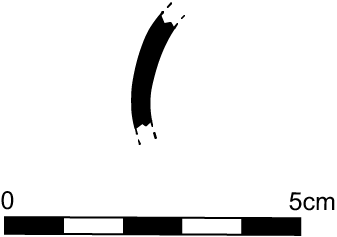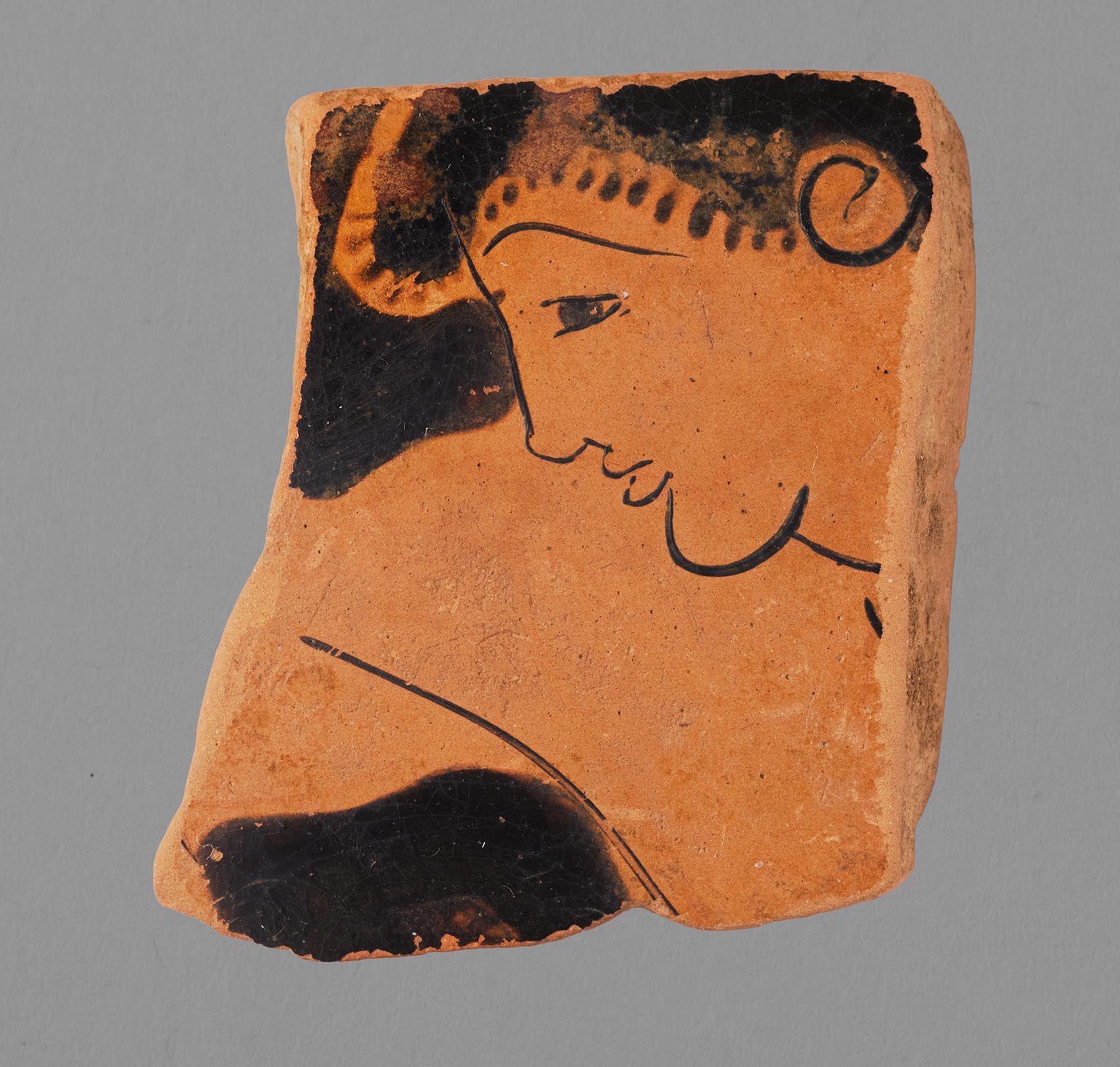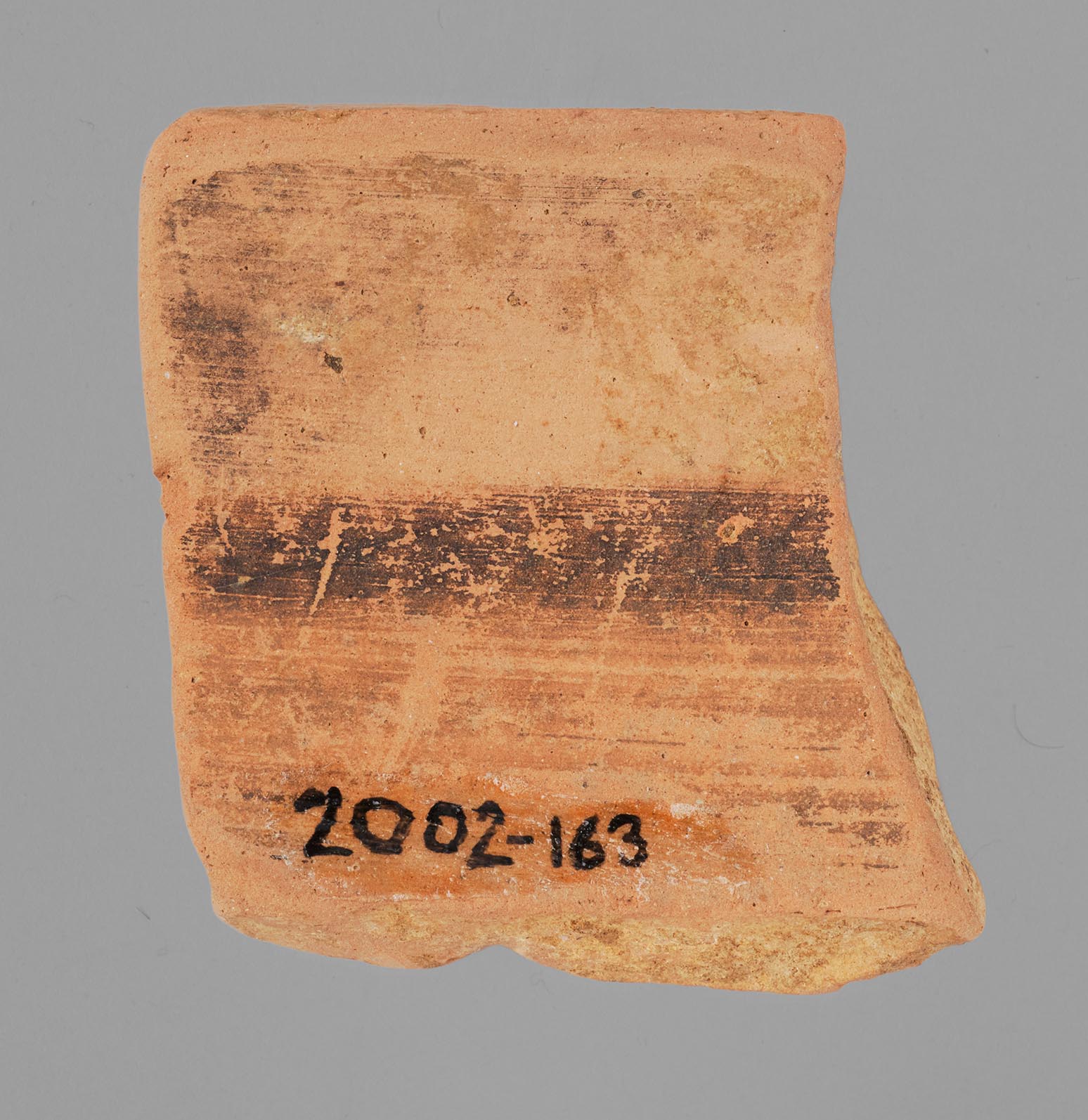Provenance
2002, gift, Cornelius C. Vermeule III (Cambridge, MA) to Princeton University.
Shape and Ornament
Single fragment from the body. Interior reserved, with streaky black lines. No ornament preserved.

Subject
Youth. The fragment preserves the head of a beardless youth in profile to the left, as well as part of his right shoulder and upper right arm and breast. At the far-left corner is a relief line, most likely from a cloak that hung from his right arm. The youth is probably a komast.
Attribution and Date
Attributed to the Leningrad Painter [J. M. Padgett]. Circa 470 BCE.
Dimensions and Condition
3.5 × 3.1 cm; thickness 0.7 cm. Broken on all sides.
Technical Features
Relief contour only for the nose. Accessory color. Dilute gloss: fringe of the hair.
Bibliography
Abbreviation: Princeton RecordRecord of the Princeton University Art Museum. (1942– ). 62 (2003): 151 [not illus.].
Comparanda
Several details of the drawing are characteristic of the Leningrad Painter, for whom see Abbreviation: ARV2J. D. Beazley. Attic Red-Figure Vase-Painters. 2nd ed. Oxford, 1963 567–74, 585, 587, 1659; Abbreviation: ParalipomenaJ. D. Beazley. Paralipomena: Additions to Attic Black-Figure Vase-Painters and to Attic Red-Figure Vase-Painters. Oxford, 1971 390–91, 513; Abbreviation: BAdd2Carpenter, T. H., ed. 1989. Beazley Addenda: Additional References to ABV, ARV2, and Paralipomena. 2nd ed. Oxford: Published for the British Academy by Oxford University Press. 261–62; W. G. Moon and L. Berge, Greek Vase Painting in Midwestern Collections (Chicago, IL, 1979), 168–71; Abbreviation: Mannack, Late ManneristsT. Mannack. The Late Mannerists in Athenian Vase-Painting. Oxford, 2001, 15–17. Of particular note is the spiral ear, the long, strongly arched eyebrow, the rounded and protruding chin, the partially upturned nose, and the short fringe around the outline of the hair. The eye, an open triangle with slightly curving contours, is also typical, but occasionally the artist draws nearly circular lids, sometimes on the same vase: cf. New York 41.162.60 (Abbreviation: ARV2J. D. Beazley. Attic Red-Figure Vase-Painters. 2nd ed. Oxford, 1963 567.6; Abbreviation: BAPDBeazley Archive Pottery Database. http://www.beazley.ox.ac.uk 206493). Although little of the youth is preserved, he was most likely a komast, which the Leningrad Painter drew on numerous occasions: cf. Detroit 24.120 (Abbreviation: ARV2J. D. Beazley. Attic Red-Figure Vase-Painters. 2nd ed. Oxford, 1963 569.43; Abbreviation: BAPDBeazley Archive Pottery Database. http://www.beazley.ox.ac.uk 206531); Bologna 266 (Abbreviation: ARV2J. D. Beazley. Attic Red-Figure Vase-Painters. 2nd ed. Oxford, 1963 568.22; Abbreviation: BAPDBeazley Archive Pottery Database. http://www.beazley.ox.ac.uk 206509); Los Angeles 48.25 (Abbreviation: ARV2J. D. Beazley. Attic Red-Figure Vase-Painters. 2nd ed. Oxford, 1963 567.3; Abbreviation: BAPDBeazley Archive Pottery Database. http://www.beazley.ox.ac.uk 206490). The pose of the youth, in particular the lowering of the chin beneath the shoulder, is also a standard feature of the artist’s komasts, as can be seen, for instance, on the krater in Detroit (supra). The relief line at the far-left corner most likely comes from a cloak draped over the komast’s extended right arm; cf. the komast on the far right of side A of Syracuse 35185 (Abbreviation: ARV2J. D. Beazley. Attic Red-Figure Vase-Painters. 2nd ed. Oxford, 1963 567.12; Abbreviation: BAPDBeazley Archive Pottery Database. http://www.beazley.ox.ac.uk 206499). The Leningrad Painter drew komoi with at least two and no more than four figures, often carrying musical instruments, wine skins, various drinking vessels, and, less often, a column-krater. Female musicians occasionally take part in the revelry as well. For a sense of the range of the Leningrad Painter’s komoi, cf. Basel Z 348 (Abbreviation: ARV2J. D. Beazley. Attic Red-Figure Vase-Painters. 2nd ed. Oxford, 1963 567.9; Abbreviation: BAPDBeazley Archive Pottery Database. http://www.beazley.ox.ac.uk 206496); Vienna 947 (Abbreviation: ARV2J. D. Beazley. Attic Red-Figure Vase-Painters. 2nd ed. Oxford, 1963 567.10; Abbreviation: BAPDBeazley Archive Pottery Database. http://www.beazley.ox.ac.uk 206497); Naples 116117 (Abbreviation: ARV2J. D. Beazley. Attic Red-Figure Vase-Painters. 2nd ed. Oxford, 1963 567.8; Abbreviation: BAPDBeazley Archive Pottery Database. http://www.beazley.ox.ac.uk 206495).
The thickness and curvature of the fragment suggests that it belonged to a column-krater, a shape of which the Leningrad Painter and the Earlier Mannerists in general were fond. For a discussion of the shape within the work of Myson and the Earlier Mannerists, see Moon and Berge, Midwestern Collections, 168–70. For the development of the shape within the Mannerist Workshop, including the Late Mannerists, see Abbreviation: Mannack, Late ManneristsT. Mannack. The Late Mannerists in Athenian Vase-Painting. Oxford, 2001, 50–56.

